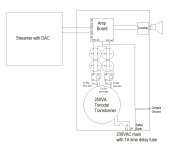Hi Everyone,
I'm building a solid state dual supply power amp, and I always remind myself that I need to take care of safety over sound quality.
But I know everything is a compromise and my priorities are:
1. Human lives
2. My humble little apartment
3. Loudspeakers
4. Streamer with DAC
5. Power supply (since the transformer and capacitor bank are the more expensive components)
6. Amplifier board (rank the lowest since the components don't cost as much as the rest)
Ideally I do not want to have a input coupling cap, and would prefer to have a crowbar at the speaker terminal instead of the regular speaker protection circuit.
Based on my plan shown in this picture, I think I should be covering my top 5 priorities, leaving my amplifier board at risk (worst case is all components / transistors are fried but will not explore or catch fire). Am I correct?
I'm building a solid state dual supply power amp, and I always remind myself that I need to take care of safety over sound quality.
But I know everything is a compromise and my priorities are:
1. Human lives
2. My humble little apartment
3. Loudspeakers
4. Streamer with DAC
5. Power supply (since the transformer and capacitor bank are the more expensive components)
6. Amplifier board (rank the lowest since the components don't cost as much as the rest)
Ideally I do not want to have a input coupling cap, and would prefer to have a crowbar at the speaker terminal instead of the regular speaker protection circuit.
Based on my plan shown in this picture, I think I should be covering my top 5 priorities, leaving my amplifier board at risk (worst case is all components / transistors are fried but will not explore or catch fire). Am I correct?
- 1A slow blow fuse at the power main inlet
- 5A fast blow fuse between transformer and bridge rectifier instead of fuse on the amp board power rails
- Speaker return back to the amp board star ground point where local power decoupling 0v and other signal 0v meet, then goes to 0v at cap bank
- 0v point at cap bank connect to chassis ground, then connect to safety earth at the power inlet
- Ideally no input coupling cap
- Crowbar instead of regular speaker protection
Attachments
How can your crowbar be 'fail safe'?
Would a traditional relay circuit be more likely to 'fail safe' and also be useful during power-up and power-down?
Your fuses will allow quite a lot of watts to be dissipated without blowing, some thermal protection might be usefully added?
Some sort of thermal switch depowers the amp and/or disconnects the speakers?
There's probably/maybe a thermal fuse in the main transformer, if that's a non-resetting type, you want to cut the dissipation before it blows?
Regarding protecting the DAC, that might require thought as the whole DAC might be at some other potential than mains Earth when you plug it in?
Would a traditional relay circuit be more likely to 'fail safe' and also be useful during power-up and power-down?
Your fuses will allow quite a lot of watts to be dissipated without blowing, some thermal protection might be usefully added?
Some sort of thermal switch depowers the amp and/or disconnects the speakers?
There's probably/maybe a thermal fuse in the main transformer, if that's a non-resetting type, you want to cut the dissipation before it blows?
Regarding protecting the DAC, that might require thought as the whole DAC might be at some other potential than mains Earth when you plug it in?
Ideally I do not want to have a input coupling cap
keep the amps input cap, remove the output cap from the source instead.
Crowbars are self-destruct mechanisms typically - one fault and you destroy the amps output section. Anecdotally and rationally its a poor approach. Combine it with DC-coupled amp and you're pretty much guaranteed to blow up the amp in short order.
However if you engineer the amp's internal protection to survive an indefinite short-circuit without popping any semiconductors, then a crowbar can be viable. Input network should act as roofing filter for both ultrasonic interference, RF and DC - there's no place for any of them in an audio amp, ultrasonics can pop your tweeters, fry the Zobel network and dissipate a lot of power. RF is just going to break-through to the audio if not excluded and be annoying, and DC damages speakers up.
Most protection systems include switch-on delay to de-thump power up, a crowbar cannot do this.
However if you engineer the amp's internal protection to survive an indefinite short-circuit without popping any semiconductors, then a crowbar can be viable. Input network should act as roofing filter for both ultrasonic interference, RF and DC - there's no place for any of them in an audio amp, ultrasonics can pop your tweeters, fry the Zobel network and dissipate a lot of power. RF is just going to break-through to the audio if not excluded and be annoying, and DC damages speakers up.
Most protection systems include switch-on delay to de-thump power up, a crowbar cannot do this.
